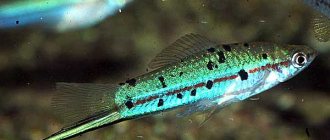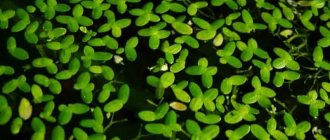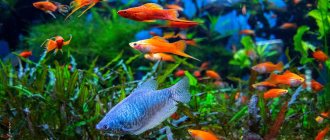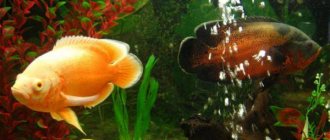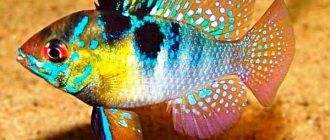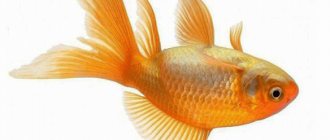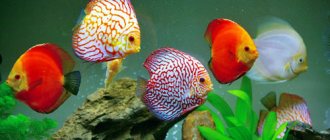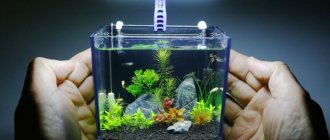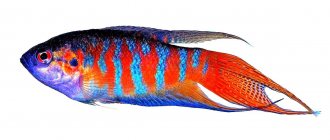Description
The aquarium fish Botsia leads a bottom-dwelling, twilight lifestyle, and prefers to stay in a school.
Good compatibility of the aquarium fish Botsii with other “population” of the aquarium was noted. They rarely come into conflict with their neighbors. And they practically don’t quarrel with each other. And yet, these are territorial fish. They are often able to drive away anyone who encroaches on their domain.
In their natural habitat, these fish are common in small biotopes (rivers, streams) of Southeast Asia.
The request “aquarium fish botii photo and description” makes it possible to see various representatives of the family. Most of them have a torpedo-shaped body, triangular in cross-section. This structure (with a flat belly) is usually characteristic of fish that lead a bottom-dwelling lifestyle. The mouth, located in the lower part of the sharp stigma, is also adapted for taking food from the ground. Moreover, there are several pairs of antennae around it that are highly sensitive.
Beware of Spikes!
Botsia has small growths in the form of spikes under its eyes. When the fish is in a calm state, they are practically invisible. But as soon as she becomes alarmed, interesting metamorphoses occur. The spines increase in size and protrude forward. We can conclude that they perform a defensive (and sometimes offensive) function. This “piercing weapon” is capable of causing serious injuries to the offender, as it has a bone base. It is strictly forbidden to use polyethylene bags filled with water as a carrier for Bots. Being in a stressful situation, the fish is able to quickly make holes in thin cellophane.
The lower fins and abdomen of Botsii are equipped with small suction cups. This gives them the opportunity to attach to various stones, snags, and bottom soil.
These representatives of loaches can “boast” of the bright colors of various color combinations. What color a particular species will have depends on several conditions. This:
- environment,
- hereditary factors
- living conditions.
The same reasons affect the size of fish, which on average is 10–15 cm in captivity, and 20–30 cm in the wild.
Aquarium fish Botsia, as well as wild ones, do not have pronounced sexual dimorphism. Until the age of five, it is not possible to determine which of them is male and which is female, especially not for a specialist. The most obvious difference is the slightly larger size of the females and the bulge of the abdomen. Although this is not an accurate indicator. It is also believed that males are not only slimmer, but also have brighter colors.
How long Botia live in an aquarium depends on the conditions of their keeping. The size of the aquarium, the quality and temperature of the water, diet, etc. are important. On average, the life cycle of these pets in captivity is 20 years.
About the conditions necessary for a prosperous life
Botia is an aquarium fish, the maintenance of which cannot be called difficult, except for the fact that its reproduction in artificial conditions is almost impossible.
Marble battle
Marble botia requires water of ideal purity. The degree of its aeration should be maximum, especially if the size of the aquarium is less than 200 liters.
It is imperative to have powerful filtration units: mechanical impurities in the water and on the ground can serve as traumatic factors for such fish.
Botia clown
The macracantha botia (another name is clown) has a known habit of lying on the ground (sleeping or just resting). This kind of time spent “on your side” seems strange at first. Then you get used to it. However, you should always remember: the soil for macracanths needs to be soft, without hard or sharp parts. The territory should be made in the form of grottoes and caves, have many labyrinths where the loach family can realize their natural instincts.
Conditions of detention
Keeping aquarium fish Botsiya is not a very complicated process if you keep them in schools. Some of their varieties (clown botia, for example) can be kept at home from 3 pieces per aquarium. And others need a “family” consisting of 6 individuals, no less.
The size of the aquarium should be selected based on the number of fish and their size. On average, an aquarium for bots (flocks of 6 - 10 individuals) should have a volume of at least 250 liters. Take into account that these pets are capable of growing up to 15 centimeters or more.
For smaller species of fish (dwarf loach, for example), a container of 150 liters per school will be sufficient. A smaller volume will no longer be suitable.
- The average water temperature for Botsy is +24°C - +27°C. Although some of their species tolerate cooler (+22°C) conditions well. And others require warmer water (+29°C).
- Moreover, each type needs a certain hardness (6 – 20 units). For example, clown loach prefers 6 – 12 units. rigidity.
- The required Ph (acidity) level also varies slightly depending on the type. On average it is 6.5 - 7.5 units.
For bots, clean water with good aeration and filtration is very important. At the same time, every week a quarter of it is replaced with fresh one.
An aquarium for keeping bots can be equipped with various stones, driftwood, grottoes, castles and other attributes of the underwater landscape. It is better to choose plants with wide leaves, in the shade of which a twilight that is comfortable for these fish is formed.
For bottom dwellers, soft types of soil (small pebbles, sand, fine-grained, rolled gravel) are more suitable.
If some species of fish prefer to feed on live algae, the plants are replaced with artificial ones.
Most of the bots are active in the evening and at night. That's when they go in search of food. Therefore, you should not equip the pond with bright lighting, or place it in places illuminated by the sun.
Often, bots sleep during the day in the “belly up” position. This is considered normal, but can be intimidating for a novice aquarist.
Maintenance and care
Feeding
As already noted, Botsia eat any food, so their diet should be varied and balanced. They willingly feast on:
- larvae;
- bloodworm;
- dry flakes;
- frozen food.
It is especially important to take into account their need for plant food: for example, many aquarists give their fish cucumbers, zucchini, and melon.
If there is a lack of plant food, Botia will nibble on algae, but vegetables should also be given in moderation so that their remains do not pollute the water.
As a rule, they feed in the dark, so it is better to feed them in the evening, after turning off the lights in the room and aquarium. However, many species will forage at any time, so a strict feeding schedule must be maintained.
These fish can easily spend two or three days without food; some sources even advise periodically arranging fasting days, since Botsia have a tendency to become obese.
If there is a serious lack of food, they will try algae and also eat all the small snails, so you should not keep them hungry for too long.
Requirements for an aquarium
Botia adhere to a benthic lifestyle, so the aquarist should provide a sufficiently large bottom area in the tank. Be sure to choose a wide and long aquarium, the height of which does not matter. It should be covered with a cover glass or lid, since the fish may jump out.
These fish react negatively to sudden changes in water parameters, so they should not be placed in a newly prepared aquarium. It is better if the container with other species, algae and other inhabitants sits for 2-3 months, and only then can Botsium be introduced into it.
Optimal water characteristics
Different types of Botia require different water parameters, but the general characteristics boil down to the following recommendations:
- temperature - from 24 to 27°C (some species like cool water - up to 22°C, others, on the contrary, require a warmer environment - up to 29-30°C);
- hardness - on average, 6-20°GH (the most popular species, Botia Clown, prefers soft water - 6-12°GH);
- acidity – 6.5-7.5 pH (for some Botia these values may deviate up or down).
In addition, the fish owner must monitor the level of nitrates and ammonia - ideally, these substances should not be contained in the aquarium. In any case, 25 to 30% of the total water volume should be changed every week.
Optimal volume of water
The estimated volume of the aquarium depends on the maximum size of adult Botsiya.
It is important to remember that these fish are kept in a school of at least 5-7 individuals.
In this regard, aquariums must be large enough: for example, for medium-sized species, a capacity of 100 liters or more is suitable. Other species (for example, Clown Botia) require at least 200-300 liters for normal maintenance.
Plants
Bots love to eat algae, but it is better to plant plants in the aquarium that perform another function: they protect these nocturnal fish from light. So, algae with wide leaves (nymphea, giant Vallisneria) or floating plants (riccia, pistia) are perfect. You can decorate the container with the help of hard ferns and mosses, which are not so attractive as food.
Priming
Botia are benthic species that spend a large amount of time at the bottom. In addition, they actively dig in the ground in search of food, and use their antennae for this. Often they even sleep right on the bottom, lying on one side, which frightens inexperienced aquarists. Therefore, you need to choose coarse homogeneous sand or small smooth pebbles as the soil.
It is important to consider that these fish create a strict hierarchy within the school, and weaker individuals sometimes require a variety of shelters to hide from the dominant Bots. In this regard, at the bottom you need to place a lot of snags, caves and other artificial shelters.
Equipment
Botia live in small rivers, so they require clean, oxygenated water and a moderate current. To create suitable conditions, it is necessary to use a filter, a compressor and additional pumps that will help create water movement.
Lighting nuances
Almost all species of Botia lead a twilight lifestyle, so bright lighting is not suitable for them. The fish will simply hide from the strong light, and their health will worsen.
Of course, we must not forget about shelters in which the fish can hide.
Thus, the lighting should be dim, and the aquarium itself should be placed away from other light sources and direct sunlight.
Check-in
In nature, Botia live in schools, so they cannot be kept alone in an aquarium. A group, as a rule, consists of at least 5-7 individuals: only under this condition will the fish feel comfortable.
In addition, in a small flock they behave too aggressively and constantly chase the weakest individuals. In large groups, the attention of cocky fish will be dispersed among the rest of the Bots, so conflicts will not arise. It is better if there are 1-2 more females than males, since they usually behave more peacefully.
Compatibility
Bots cannot be called a fully aggressive fish. This is a gregarious inhabitant. If the correct hierarchy has formed in the group, then there will only be intraspecific acceptable conflicts, which constitute the way of life of these underwater inhabitants. In this case, the neighbors are unlikely to be interested in them.
The size of the flock is also important. In a small one, one weak individual is always chosen, and usually everyone else offends her. If there are at least eight copies in the family, then conflicts are distributed evenly, there is no pressure on one member.
The only Botia in the tank will feel uncomfortable and show aggression towards other inhabitants of the aquarium.
If there are other fish in the homemade artificial fish, then they should be as follows:
- angelfish;
- barbs;
- zebrafish;
- Corydoras catfish;
- gourami;
- guppy;
- mollies;
- platies;
- plecostomus;
- iris;
- rasboras;
- labeo;
- swordtails;
- tetras.
Fish with veil-like plumage are not recommended as neighbors; Botsia will nibble on it, as well as slow-moving species - cockerels, African and South American cichlids, discus fish, goldfish, Koi carp, shrimp and crabs, astronotus.
Breeding
Breeding Botsiya is a very complex process, accessible at home only to professionals. And even in this case, no one can guarantee a successful result. Some species have already learned to breed, others have not yet. Most often, juveniles are purchased from Asian fish farms, where there are all the factors to create natural conditions, but they also use hormonal injections.
The fact is that the reproduction of this fish in the wild is very difficult. During the tropical rainy season (December-February), the water level in the rivers rises significantly, and Botia moves to the upper reaches. There they lay thousands of eggs and descend downstream into valleys, swimming enormous distances of up to 400-500 km.
The masonry remains in thickets of reeds and bushes. Then, under the pressure of the spilled water, it is washed away and floats along the surface, gradually attaching itself to algae on its way. The hatched larvae initially eat plankton, and by two months they already reach a size of 2-3 cm and can hunt on their own.
During migration, eggs find themselves in different conditions with a changing hydrochemical composition of the aquatic environment. They are almost impossible to study and, therefore, reproduce when keeping fish in captivity. Only the use of hormones can help.
In order to try to get the offspring of Bots, you must perform the following steps:
- Place a couple of spawners in a spawning tank with a water temperature of +24…+26 °C. It should be taken into account that sexual dimorphism is very weak in this fish. A mature female can be distinguished only by its slightly enlarged abdomen. It is better to turn to experienced ichthyologists to form parents. Puberty occurs no earlier than 12 months.
- In the second half of the day, inject the producers with human chorionic gonadotropin, and at the beginning of the next day - with Acetonated pituitary gland of bream.
- After 4-5 hours, express the female’s eggs. To do this, fingers are passed along its sides and abdomen several times without excessive pressure in the direction from the head to the anus.
- Milk is expressed in the same way. But you only need to rub the area near the anal fin with your finger. With one procedure, it is possible to obtain 4-10 drops, but they are enough to fertilize eggs from several females. One female is capable of producing about 3 thousand pieces.
- The clutch is fertilized. To do this, milk is mixed with water and the suspension is carefully poured into a container with caviar. I help with the procedure with a quill pen.
- Fertilized eggs are placed in an incubator tank with very soft and slightly acidic water. It quickly increases in size and floats up. At +24…+26 °C, 20-22 hours are enough for it to peck.
- For the first 2-3 days, the larvae eat their yolk sac, then Artemia nauplii are added to the water. By the end of the first month, the juveniles reach 1-1.5 cm in length. They begin to gradually increase the hardness of the water environment.
Diseases and prevention
All diseases that Bots owners encounter are most often caused by violation of the conditions of their maintenance. The most common pathologies are of the following nature:
- Gribkova. Usually this is gill and fin rot, the formation of a grayish mossy coating on the body of the fish. Methylene blue and Metronidazole are used for treatment.
- Parasitic. These include lesions by protozoa, the most common being ichthyophthyriasis (semolina). The fish itches on the ground, and whitish “cotton” lumps appear on the body. Malachite green and Formalin are used for treatment. Salt water and preparations containing copper and iron are prohibited. Botia are very sensitive to the composition of the aquatic environment.
- Bacterial. Typically, owners are faced with aeromonosis, vibriosis, corynobacteriosis, hemophilia, pseudomonosis, and tuberculosis. All of them are successfully treated with antibiotics in the early stages. But consultation with an experienced ichthyologist is necessary.
Another problem for Bots is obesity, which is caused by gluttony of fish. Here, only the owner can prevent pathology by limiting portions and preventing overeating
Interesting Facts
A few of them:
- Botsia are bright fish. But their color becomes discolored under stress or fear, or from old age. Then the fish practically merges in color with the bottom filler and becomes invisible. When excited, on the contrary, all shades of color are very bright.
- If the fish does not have time to hide in case of danger, then it pretends to be dead.
- She also sleeps - belly up, on her side or head down. An inexperienced aquarist usually gets scared, thinking that the pet has died.
- Before it rains, a flock of Botsy begins to worry. That is, they are a kind of barometer.
- Botia serve as cleaners of artificial home ponds from overly proliferating snails - for them it is a delicacy.
- Almost all fish species can interbreed, producing interesting new offspring. But only in natural conditions or with the help of hormones.
- In Asia, collecting the floating caviar of Botius is a good source of income. It is sold to fish farms. But natural fish populations suffer incredibly from this “business.”
Should I choose the first fish?
Botsia are amazing bottom-dwelling fish, prone to nocturnal lifestyle. Their contents differ in some features, but if the recommendations are followed, even novice aquarists can keep them. With good care, they will delight the owner for a long time with their attractive appearance and unusual habits.
BOTIA PULCHRA: CONTENT IN THE AQUARIUM, PHOTO
CHESS BOTIA (BOTIA KUBOTAI): DESCRIPTION, BREEDING, CONTENTS, PHOTO.
BOTIA MORLETI: DESCRIPTION, CONTENTS, PHOTO, VIDEO.
BOTSIA DARIO (BOTIA DARIO) OR BENGAL BOTSIA.
BOTIA LOHACHATA CHAUDHURI, BOTIA ALMORHAE
Dwarf botsia: DESCRIPTION, CONTENTS, BREEDING, PHOTO, VIDEO, FEEDING.
BOTSIA HELODES (SYNCROSSUS HELODES)
MARBLE BOTTIE: CONTENTS, CARE, COMPATIBILITY, PHOTO, DESCRIPTION
BOTIA MODESTA: MAINTENANCE, CARE, BREEDING, FEEDING, COMPATIBILITY, PHOTO, VIDEO
Compatibility
The compatibility of Botsii with other fish will not raise questions if they stay in a school. Usually they communicate with each other, but do not show negative emotions towards their neighbors. Of course, unless they start claiming their territory. Another thing is that Botsia is a loner. Due to lack of communication, it may well conflict with other species of fish.
When choosing “neighbors” you need to take into account the size of Botsiya and their nightly burst of activity. It is advisable to place fish with similar temperament, size, and character together. These are angelfish, barbs, and large viviparous gouramis.
Neighborhood with veiled fish (cockerels, veiltails, golden ones) will not bring anything good. The luxurious fins of such pets can be damaged by bots.
Corydoras catfish are also not the best example of compatibility. Serious territorial problems and food competition may arise here.
Some types of aquarium fish Botsius happily eat snails, which should also be taken into account when introducing mollusks to them.
Compatibility with other fish
Some aquarists believe that Botia is a very aggressive fish that always bullies its neighbors. In fact, under suitable conditions, these fish behave quite peacefully and can live peacefully with many species.
However, when populating an aquarium, you need to remember that Botians are very large and active fish, so cohabitants must have similar characteristics. The following types are best suited for living together:
- Angelfish;
- Rainbows;
- Gourami;
- Barbs;
- large viviparous.
Botia compatibility chart
You should not add fish with long veil fins (Cockerels, Goldfish), as Botia will bite them. Conflicts with Corridors also often arise.
Feeding and diet
It is very important that the diet of these fish is varied and balanced. Given their predatory nature, it is advisable to use live food (bloodworms, tubifex, etc.). At the same time, there is a large selection of special food in tablets intended for bottom fish.
Fruits and vegetables are suitable as feeding. For example, fresh cucumbers, zucchini, melons.
Food is offered to the bots when the lights are off, as they are accustomed to feeding in the dark. But they are ready to consume their favorite food in any conditions, which often leads to overeating.
Nutrition
Eating in an aquarium is not difficult.
Fish are omnivores and eat any type of food. They enjoy eating dry food, high-quality chips, granules, and tablets. Live or frozen bloodworms, correts and tubifex will be welcome. Be sure to add plant foods to your diet: special tablets, cucumber, melon, blanched spinach and zucchini. Fish destroy snails, including ground melania. They are carnivorous by nature, but can also feed on plant foods, including aquatic plants with soft leaves.
Breeding
In terms of breeding, the aquarium fish Botsia is quite complex. Some of its species are able to reproduce only in special conditions. On special farms, where they receive hormonal injections.
Spawning occurs in a separate container, and spawning occurs directly on the surface of the water. It is estimated that the number of eggs can reach 5–6 thousand. At a temperature of +28°C, after 18–20 hours, fry appear from them.
Parents are removed immediately after spawning so that they cannot harm their offspring.
At first, the fry's nutrition consists of the contents of the yolk sacs. And then they are transferred to special feed.
Breeding Bots at home is almost impossible. Therefore, all pet store specimens are divided into those raised on farms and those caught in the wild as juveniles.
Behavior and Compatibility
Forms complex social hierarchies and should be kept in groups of at least 5 or 6 individuals, preferably 10 or more. Many sources say that keeping them in smaller numbers leads to increased aggression and greater secrecy. In the first year of life, they quickly reach 8-10 cm in length, then growth slows down and this happens spasmodically in the future.
A very nimble and cheerful fish, it can spend hours near the viewing glass, amazing with its dances, begging for food. It is interesting that the entire flock, young and old, is involved in this dance, and occupies the entire aquarium in area, both in length and in height, the spectacle is very beautiful and unforgettable.
Their cheerful and hooligan character will decorate any aquarium. The beauty of a group of different ages is especially emphasized; it is advisable to replenish the flock with young people at least once a year.
Another feature that cannot be ignored is the ability to swim in all positions; fish have a very high speed; their skillful maneuvering between objects is amazing.
They also have excellent reverse movement, which prevents them from getting stuck in shelters. Do not sound the alarm when you see your pet literally squeezed into a gap in a position that seems inexplicable to you. They sleep in every position they can think of. The aquarium should contain various shelters; through-type ones are best suited for this. Like many bots, they can make guttural sounds similar to clicking or clicking.
Kinds
There are several of the most popular species of Botia, which are often kept in home aquariums.
Botia clown is the most famous representative of this family. It can grow up to 20 cm, colored golden-orange with dark transverse stripes.
Chess. It grows up to 10 cm, has a light orange color with blue and black stripes. There are also stripes along the transparent caudal fin.
Marble. The size of an adult individual is 7–9 cm. The body has a yellow–milky color with black spots of irregular shape. Life span is 7 – 9 years.
Modest. Can reach 22 cm. Body color is gray-blue, fins are orange.
Tiger. It has a color corresponding to its name. The number of stripes reaches 12–15 pieces, and the dimensions are 29 cm. They show increased aggression and activity, and feel more comfortable in a flock of 6–8 individuals.
Zebra (striata). It is colored sandy, with narrow diagonal stripes running from the back to the belly. The shape resembles a clown, but the size does not exceed 7 cm.
Appearance
The color options are varied in their patterns and colors. Thus, Emperor and Dario have a basic yellow background with vertical dark brown stripes located on it.
Botsii striata
On the body of Botia striata (Botia zebra), the arrangement of stripes in groups is clearly noticeable, between which there is a wide base stripe. Another characteristic property of the striatum is the reddish color of the nose. Often this feature is mistaken for an injury (digging in the ground, it costs nothing to get an abrasion on the nose). However, it is not. A pink nose is a characteristic feature of this variety.
Diseases
By and large, adult fighters do not have to complain about their immunity. They are quite resistant to various pathogens. Although it is possible to become infected with ichthyophthyriasis (semolina), as well as other fungal infections.
Botsiya fish are treated by increasing the temperature, adding antifungal drugs to the water, and isolating them from light. But even a general epidemic may not affect some of the Bots. Healthy individuals should not be placed in another container while the rest are being treated. This will be a preventative procedure for them.
Notes
The vast majority of Chromobotia macracanthus for sale are wild caught.
Every year about 20 million fish are exported from Indonesia. Due to the fact that they had to be caught with large interruptions in time (due to the rainy season, which affects the course of the fish), the market weakened for a time. Fish practically disappeared from mass sales in the fall and early winter. However, this problem has now been resolved and steps have been taken to ensure a permanent supply of these loaches. They began to keep the bots in special cages; large structures and reservoirs were built right in their habitats, as well as in cities, and conditions were created for keeping the fish. There is also an additional opportunity to raise juveniles, since larger individuals have a higher cost. For Indonesian fishermen, income from the sale of these boats in some cases is almost one of the ways to feed their family.
Catching these fish is quite varied. But I would like to talk about one of them in more detail. To make the “tackle,” hollow bamboo is taken, then it is dried for two months (since, according to local fishermen, the smell from fresh bamboo repels fish). After drying, the bamboo is cut into pieces up to about two meters (depending on the depth of the catch site), and a hole is made in each segment of the bamboo.
The finished tackle is loaded with a stone on one side (so that the bamboo does not float up), the other end is tied to tree branches hanging over the water. The main fishing usually occurs at night, as clowns look for shelter and swim into bamboo segments, through holes, following their habit (hiding in all sorts of cracks). After several hours, the snares are checked and shaken out into prepared dishes. There are different variations on this method of fishing, but the basic principle remains the same, built on the instinct of the fish.
Recently, they have begun to catch “larvae,” newly hatched fry of bots. They spawn in flood fields. After the flood, the water rushes back into the rivers, carrying with it a large number of fry, and this is where they are caught, blocking the channels with peculiar “fences”.
Reproduction of bots
Bots are bred exclusively by professional and experienced aquarists, and even in this case, not everything is always successful. The process of creating conditions for spawning is very complex. For spawning, it is necessary to create temperature fluctuations, monitor aeration, add hormonal drugs and, in some cases, even try to recreate the flow. That is why this process is very complicated and we will not consider it in detail. Let’s just say that female bots produce high-quality caviar at the age of 4-5 years. There are no gender differences in females and males. At the same time, only a few types of bots could practically be bred in an aquarium and, as we said, with a significant change in conditions relative to the conditions of ordinary keeping of these fish.
Content
Keeping clown bots involves purchasing not just one fish, but a school of 3-5 fish. In this case, you should purchase a spacious and huge tank - from 150 liters for one clown, for five pets - from 400 liters.
Water parameters:
- Temperature – 24-29C.
- Hardness – 1-5 dH.
- Acidity – 6-7 pH.
Water changes are performed weekly, replacing 1/3 of the volume. During fluid renewal, the soil should be siphoned off from contamination. As a substrate for breeding clown bots, you need to choose soil with small, smooth particles - for example, sand or pebbles, so that the fish do not injure the delicate scales. The vegetation in the aquarium where the clown botia lives is planted alive, with hard and durable leaves. Ideal options would be Cryptocoryne, Anubias and fern species. Since loaches prefer dim light, Riccia, Salvinia or duckweed are used for darkening.
The presence of shelters in the aquarium - grottoes, caves and other secluded places - is also important. Decorative elements must be smooth and safe so that the bots do not get hurt. The tank is charmingly equipped with a lid, since clowns are active and restless pets that often jump out of the tank.
Interesting fact: botia fish sleep on their sides or backs, sometimes managing to fall asleep even in the narrow crevices of grottoes.
External characteristics
Botia fish is very popular among aquarists. It belongs to the Convolvulaceae family and is distinguished by a torpedo-shaped body and a flat belly. The sharp muzzle is decorated with 6-8 antennae. In the natural environment, the body length reaches 50 cm, and in an aquarium it can grow up to 25 cm.
Small spikes are clearly visible on the muzzle under the eyes . When the fish is alarmed by something, the spines protrude and stick out horizontally. In a calm state they are hardly noticeable. Their injections are very painful, which must be taken into account when purchasing: fish cannot be moved in plastic packaging.
There are small suckers on the fins in the abdomen and chest area . With their help, the fighting dog adheres to various objects in the water. This is an aquarium substrate, driftwood and various types of vegetation.
The color of botia fish varies depending on the variety. Color is influenced by habitat and heredity. They become especially beautiful during the spawning period.
https://youtube.com/watch?v=Dz-0bHYKpnc
Diseases and prevention
The body of the fish is poorly protected and is therefore susceptible to infections and parasites. If the disease is not detected immediately, it cannot be treated in the later stages. Medicines prescribed in such cases for other species are not suitable; they are toxic for the Clown.
White rashes on the body are a symptom of the parasitic disease ichthyophthyriosis. Cause of infection: dirty food, shellfish entering the tank from natural reservoirs. In the early stages it can be treated, but it is better to immediately consult a specialist, since not all drugs are suitable for Botsia.
Poisoning with water containing the wrong chemical composition is not uncommon. Chlorine and ammonia are often present in tap water:
- When intoxicated with chlorine, the fish loses its brightness, mucus appears on the gills, and the pet makes attempts to leave the pond. In this case, urgently transplant Macracanta into fresh liquid and turn on maximum aeration.
- Ammonia poisoning occurs when the tank is contaminated with waste products. The flock rises to the surface, gasping for air from the surface. Replanting is contraindicated; add additional biofilters and increase aeration.
- Oxygen deficiency can cause the death of a pet. Occurs when there is a prolonged lack of air in an overcrowded tank with a small amount of algae.
When the skin is injured, ulcers may appear. The disease is not contagious, but painful for the pet. The wounds are open and inflamed; antibiotics are used for treatment as prescribed by an ichthyologist. Botsia is taken to quarantine so that the neighbors do not bother her.
Reproduction
Fish become sexually mature around the fifth year of life. In order to achieve spawning, the water in the aquarium is increased to approximately 31 - 32 degrees. Weekly water changes should be reduced to allow the liquid in the aquarium to age. Since in nature the clown botia breeds in rivers, imitation of the flow is a prerequisite. A strong flow of water can be created using an underwater fan - a “spinner”. It is also worth taking care of the basis for the eggs - this can be driftwood, rough stones, and other objects.
However, even having created conditions close to ideal, it is extremely difficult to obtain spawning, and even more so offspring in the form of fry, in a room aquarium.
In some fish farms in Indonesia, the process is optimized using gonadotropic agents. But most often, fry and juveniles are simply caught in reservoirs, some of which successfully reach pet stores, and from there to aquarists.
Fish in natural conditions
Botia clown - according to scientific Chromobocia macrocanthus, is a tropical species that lives in freshwater bodies of Indonesia. This species has been known to Europeans since the 19th century. This brightly colored fish lives mainly in rivers, and during spawning it rises to smaller branches and streams. Botia has been bred in aquariums since 1936. Due to the difficulty of obtaining offspring in captivity, fish supplied to pet stores are caught directly in the inland waters of Indonesia.
Popular varieties
Each species is distinguished by characteristic stripes or spots of contrasting color. However, there are representatives whose color is more uniform and not so bright.
The following types of fighting are considered the most popular :
- Morleti (botia mouse) is a relatively small fish, since it grows only up to 10 cm. It is very demanding on water temperature, it should be within +26...+30 ° C, it needs dim lighting.
- Royal (Beardmore) - the color resembles a tiger, body length is up to 20 cm. It loves a nocturnal lifestyle and almost always stays in dense thickets. Can reproduce in aquarium conditions.
- Dario is a fairly active fish, prone to depression from boredom. Can eat smaller tankmates. It is advisable to keep them in small flocks of 5-6 individuals.
- Lecomte - this representative is most adapted to breeding in captivity, distinguished by a calm and loyal attitude towards other inhabitants of the tank. Body length 12−15 cm.
- The zebra stands out for its contrasting black and gold color, which is why it got its name.
Zebra botia does not produce offspring in captivity.
Reaches 15 cm in length; in captivity it is not capable of producing offspring. She has an active character and it is better not to keep her in the same aquarium with smaller fish. - Blue (Modesta) - the most popular botia, stands out for its beautiful appearance with a noble blue tint. Grows up to 20 cm. Loves a filled artificial house with vegetation and driftwood.
- Mankranta (Clown) is the most prominent representative of the bots. Often clicks its spines in the evening, loves large companies of its fellows and dim light. The average body size reaches 15 cm.
- Dwarf - it is also called hummingbird because of its small size (about 6 cm). Very peaceful, leads a diurnal lifestyle.
According to various sources, there are 25-30 species of botia. They all differ in appearance, character and requirements for living conditions in the house.
https://youtube.com/watch?v=9k8hyuVJKFE
Lifestyle
In their natural habitat, bots are found in clean flowing water bodies. These fish live well in schools, groups of 6-7 individuals, so they cannot be kept alone. Loneliness leads to aggression, which they take out on other inhabitants of the aquarium. Life expectancy is about 20 years.
Most species of botia are nocturnal , which limits the opportunity to observe them. A characteristic feature of this type of fish is the absence of scales. This can be dangerous if kept at home.
During the daytime, they prefer to lie on the bottom of the aquarium, sitting with their belly up or on their side. This position makes you think that the fish has died, but this is just their style of swimming in a dream. They like to drift like this in the daytime, burrow into secluded areas, hide in the substrate and tumble.
Content Features
Bots are considered schooling fish, so you need to buy several of them so that they do not show aggression towards other inhabitants. They need water movement in the aquarium, because they are river representatives. To do this, the container is equipped with a powerful filter, which not only provides water purification, but also creates small currents.
Their nocturnal lifestyle forces them to hide during the day in secluded places. To do this, they need different types of shelter :
- driftwood;
- stones;
- grottos.
The main thing is that such objects do not have sharp protrusions, as they can injure the combat weapon. Decorative elements should be positioned so that there are no too narrow gaps. The fish should be able to freely enter and exit them without any obstacles. Floating algae is necessary for free movement and play.
Botia love bodies of water with currents, so your aquarium will need a powerful filter.
It is better to choose dim and diffused lighting. Brightness will lead to an aggressive state. Since bots like to lie on the bottom, it is advisable to choose soft soil for safety reasons. The naked body will be injured by the rough substrate and abrade the skin in the area of mucous secretions.
The water in the aquarium should be constantly crystal clear, so it is recommended to change it every week and saturate it with oxygen as much as possible. The optimal temperature for keeping is +24…+26 ° C.
Culinary preferences
Bots are not particularly demanding when it comes to food, but are nevertheless considered gourmets. The diet should be balanced and varied. They cannot be fed only with plant or meat products.
Popular meat foods include:
- earthworms;
- bloodworm;
- mosquito larvae;
- tubifex;
- crustaceans;
- brine shrimp.
Food for bots should be varied; you cannot feed them only one type of food.
Due to lack of protein, they will begin to eat aquarium snails. Bots also love plant foods :
- spinach;
- zucchini;
- cucumbers;
- melon.
They prefer fresh vegetables and fruits and do not refuse vegetation in the aquarium. It is advisable to equip it with fast-growing algae so that they are renewed more often.
Reproduction process
These representatives are rather reluctant to reproduce at home. This is explained by a complex reproductive process: in the natural environment, adult fish migrate to spawn. To do this they must reach a certain age.
Now they have learned how to produce offspring on special farms in Southeast Asia using hormonal injections. The maximum number of eggs reaches 5-6 thousand . The most common option for obtaining a young specimen is to catch the fry in the natural environment. It is then raised to produce mature and charismatic fish.
Feeding
A natural predator and in captivity prefers live food. At night, Botsia's appetite is much higher, and accordingly, they behave more actively. The pet is pampered with corret, tubifex, frozen bloodworms and worms.
In order not to infect the fish with parasites, it is important to monitor the purity of the feed or freeze all food. Some breeders treat food with a weak solution of potassium permanganate.
For those who do not want to bother with live food, they can use ready-made dry mixtures for bottom fish: Sera Granu Green, Tetra TabiMin. With this diet, it is important to use herbal supplements, such as zucchini, cucumbers, spinach, lettuce, dandelion and nettle. Before serving, vegetables are treated with boiling water.
Features of reproduction and breeding
Clown botia has difficulty reproducing in captivity
In the natural environment, loaches move upstream each year to spawn, which lasts from December to February. During this period, the water in the rivers rises to its maximum level. The fish lay their eggs in reeds and then return to their permanent habitat. During this time they cover about 300 km. The eggs drop onto the leaves of the plants, where the larvae appear. After the water level decreases, the fry swim into the tributaries of the rivers, from which they move to the main channel, where they mature.
It is difficult to grow macracanths in an aquarium; only isolated cases of producing offspring are known. Individuals that are supplied to pet stores are imported from Sumatra. The exact age at which clown loaches produce offspring has not been determined. Presumably, this figure is 7–8 years.
For breeding, it is important to observe the following features:
- You will need a separate aquarium in which the water temperature is set between 24–26°C, hardness 6°, and acidity 7 units.
- A prerequisite is to ensure a strong current. You can create it using a turntable - a device built on the basis of an electric motor. 4 blades are installed on it and covered with plexiglass, vinyl plastic or wire mesh.
- The corners of the aquarium also need to be covered with sheets of plexiglass. Stones or driftwood are placed in the zone of the fastest current.
- Now you can release breeders into the spawning area: four males and one female.
- The fish are given hormonal injections. The procedure is performed in two stages. For the first injection, the drug human chorionic gonadotropin is used. To prepare the second injection, acetonated bream pituitary gland and Bicillin 5 are used. The solution is injected with a syringe into the first third of the back above the lateral line - below the dorsal fin. The female is ready to breed 6 hours after the last injection.
At the end of spawning, the spawners are removed from the aquarium and the spinner is turned off. The temperature is raised to 30°C. Unfertilized eggs that are white should be removed to avoid the development of bacterial infections.
The incubation period lasts 18–20 hours, after which the larvae appear. They hide in the darkest places of the spawning ground, so it is difficult to notice them. After 3–4 days, the yolk sac resolves and the fry begin to eat. The young are given nauplii of cyclops, small rotifers and green euglena. After a month, the fry grow to 15 mm and acquire a characteristic color.
Important! Sprayers are installed in two different corners of the aquarium so that the eggs remain in the water column and do not stagnate.
Some aquarists prefer to express the eggs by applying pressure at the location of the ventral fins. Milk is obtained from the male in a similar way. The procedure is carried out in a dry container; the fish are also pre-wiped with a dry cloth. Next, the eggs are mixed with milk, and after that water is added, which should only cover the eggs. After five minutes she is placed in the incubator.
Origin of the species and description
Photo: Botsia the clown
The first description of this bright and unusually beautiful fish was made in 1852 by the scientist and Dutch explorer Blekker. In 1852, he was in Indonesia and watched the fish very closely for quite a long time. He described that the islands of Borneo and Sumatra are considered to be the birthplace of clowns. During the breeding season, they rise up and accumulate in huge quantities at river mouths.
Video: Botia clown
They first appeared as aquarium fish in the 19th century. For a long period of time they were imported as aquarium inhabitants from Indonesia. Today, they are successfully bred in special nurseries or in aquarium conditions. In 2004, Mauris Kottelat isolated it from the genus Botius into a separate, independent genus. The name makracanthus comes from the ancient Greek language. Translated into Russian it means “large thorn.” This name is due to the presence of protective spines, which are located in the infraorbital region.
In Russian, the fish is often simply called a clown because of its bright and unusual coloring, as well as its mischievous and very fast, playful disposition. Fish quickly spread almost throughout the world as aquarium inhabitants. Entire families start them.

